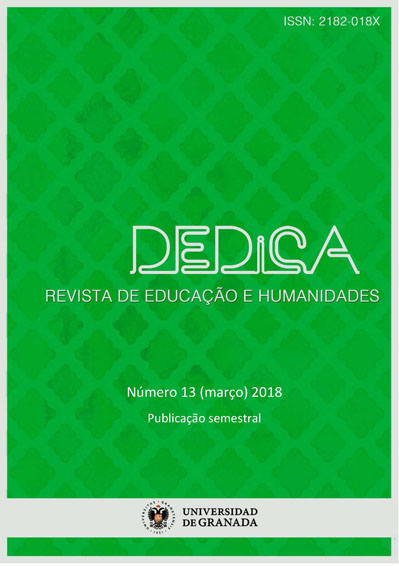From the intervention in colour in a “Winter garden” to the black and white in the Gguernica” by Picasso. Two experiences of Contemporary Art in a Secondary School in rural environment. Plastic, visual and audiovisual active methodologies
DOI:
https://doi.org/10.30827/dreh.v0i13.7244Keywords:
projects, Land Art, contemporary, Guernica, methodologies, innovation, plastic educationAbstract
During the academic year of 2016/2017, at the Secondary School of Albarracín, we have developed two artistic projects in the Plastic, Visual and Audiovisual subject with students of 2nd and 4th year of ESO. These localized interventions, which were made outside the classroom and integrated with learning processes that require teamwork, understanding of the artistic language in its less academic representations, initiate them in the analysis of the relationship between history and art and how this one makes clear that the artist´s sensitivity with the social and historical context that he or she has to live. From the possibilities offered by recycled materials, with a bit of creativity, and using procedural resources, born with the avant-garde, the work is innovative. It allows the development of projects, involving a rural community of students between 12 and 16 years old, which are integrated into common projects, either with direct intervention or with the presentation of them to other courses, opening new fields of experimentation. Many ways to the experience of ephemeral art, to the adaptation of unusual spaces for its exhibition have been given and, in all of that, they identify themselves as the true protagonists of a learning process which is integrated in the day to day of the school center. These two points of intervention, located outside and inside the school, are the garden which gives access, with its allusion to “Land Art” (from the 70s), and the mural exhibition of the reinterpretation of the Guernica in a passage space situated inside it.
Downloads
References
AAVV. (2011). Didáctica de las Bellas Artes y la cultura visual, Madrid: Akal.
Acaso, M. (2009) La educación artística no son manualidades. Nuevas prácticas en la enseñanza de las artes y la cultura visual. Madrid: Catarata.
Acaso, M. (2013) rEDUvolución. Hacer la revolución en la educación. Barcelona: Paidós.
Coleman, D. (1996). Inteligencia emocional. Barelona: Kairos.
Gardner, H. (1987) Arte, Mente y Cerebro. Una aproximación Cognitiva a la Creatividad. Buenos Aires: Paidós.
Larraz, N. (2013). “Desarrollo de la creatividad artística en la educación secundaria”. Journal for Educators, Teachers and Trainers, Vol.5 (1), 151-161.
Parini, P., (2002). Los recorridos de la mirada. Del estereotipo a la creatividad. Barcelona: Paidós.
Repollés, J. (2011). Genealogías del arte contemporáneo Madrid: Akal - Bellas Artes.
Winnero, E.; Goldstein, T. & Vincent-Lancrin, S. (2014). ¿El arte por el arte? La influencia de la educación artística. Educational Research and Innovation. México: OCDE.
Fuentes en línea:
Consultorio de la Innovación. AL SERVICIO DE LA COMUNIDAD EN LA PROMOCIÓN DE LA +D+I. Disponible en:
El jardín de invierno IES LOBETANO. Disponible en:
https://www.youtube.com/watch?v=fha78I2VSmQ
Guernica IES LOBETANO. Disponible en:












